Rock of Gibraltar – Fantastic Views & Barbary Apes
I’ve been very remiss in writing about the day Alison and I spent exploring the Rock of Gibraltar. We did it on a reasonably warm day in November, 2015 and it turned out to be one of the most interesting days we’ve ever spent exploring together. Combine the excitement of the cable car ride to the top, the unbelievable views from the top, the endlessly entertaining Barbary apes, the miles of underground tunnels, St. Michael’s cave and the Pillars of Hercules and you have the recipe for creating outstanding memories. Of course, no such adventure would be complete without one of my patented screw ups that turned a decent amount of walking into a veritable marathon. There was just so much packed into this day that I will divide it between two posts. Please join me in reliving this great day.
The interesting part of the day actually started the night before as we had the tv on in our room at the Rock Hotel which sits right at the base of the Rock of Gibraltar. For some reason it was tuned to a station in Morocco which is just across the strait. I recognized a familiar music theme and looked at the tv to see Canada’s own Just for Laughs Gags on the screen. These are gags that are all done without any spoken words so they are entertaining to anyone who has a sense of humour and that apparently includes the Moroccans. Small world.
History of the Rock of Gibraltar
Anyone who grew up as a baby boomer like me was familiar with the Rock of Gibraltar from almost day one, as it was the symbol of Prudential Insurance which sponsored the iconic tv documentary series 20th Century.

How many times have you heard the expression ‘Solid as the Rock of Gibraltar’; which is quite ironic because the Rock of Gibraltar is actually the Swiss cheese of rocks. It is honeycombed with dozens of miles of tunnels, natural caves, faults and fractures to the point that it’s a wonder it doesn’t collapse.
Britain captured the Rock of Gibraltar from the Spanish in 1704 and was ceded sovereignty over it by the Treaty of Utrecht in 1713 and it’s remained in British hands ever since, despite repeated efforts by the Spanish to get it back. However, it has a far older history than just the dispute between the Brits and the Spanish. It was certainly inhabited by Neanderthals who lived in the caves on the rock over 50,000 years ago. Some think it may have been their final stronghold before becoming extinct.
The Phoenicians were here almost a thousand years B.C. and of course, the Rock of Gibraltar became one of the two Pillars of Hercules to the Greeks and Romans. After the collapse of the Roman Empire the Visigoths controlled the place until it became the landing point for the Moorish invasion of Spain in 711. The invasion was led by a guy called Tariq and the rock became known as Jebel Tariq (Tariq’s mountain). Say the name over and over and you’ll soon be saying Gibraltar.
The moors held the Rock of Gibraltar for over seven hundred years until the Castilians captured it in 1462. So between the Neanderthals, Phoenicians, Greeks, Romans, Visigoths, Moors, Spanish and Brits, you can safely say that ‘a lot of shit went down here’. Alison and I are about to examine some of it.
The Cable Car
Despite all the above groups, it was the Swiss who came up with the idea of building a cable car to the top of the Rock of Gibraltar. While there are narrow roads that actually do go right up to the top, they are closed to all but official travel so the cable car is the only way up unless you want to walk and we don’t. Most visitors take the cable car up and then gradually walk down the roads and paths that lead to all of the things most people want to see. Here’s a map of the rock. You can just make out the dotted line showing the cable car route which ends petty well in the middle of steep crest that makes up the top of the rock.
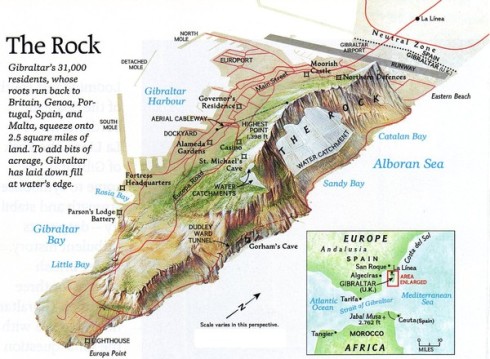
The first cable car run is at 9:30 and Alison and I are there waiting. There are only four people in the first car up and one of them took this picture of us in the cable car. I’ve got my Gibraltar hat on so I’ll know where this was taken twenty years from now when I’ll probably be a doddering fool.
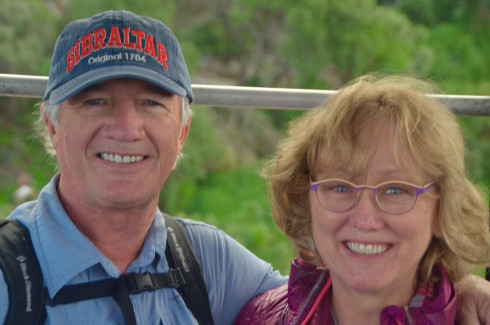
The view of Gibraltar from the cable car is fantastic as you would expect. Unfortunately there was this huge black cloud that seemed to materialize out of nowhere and just cover the top of the Rock of Gibraltar. I presume it is some kind of phenomenon caused by the promontory’s position at the end of the Iberian peninsula.
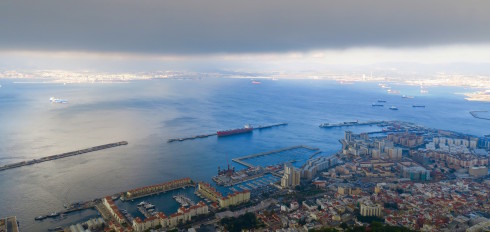
This is what the cable car looks like as it pulls into the station at the top.
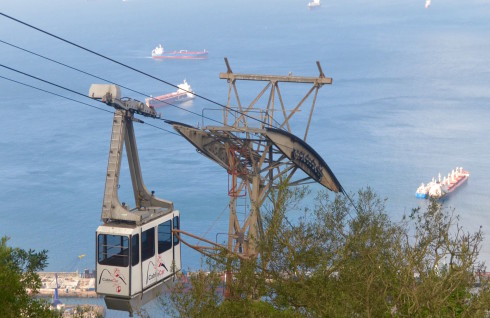
On Top of the Rock of Gibraltar
On exiting the cable car there are a number of things to be seen in the observation deck area including of course more fantastic views. This is looking north along the spine of the Rock of Gibraltar. There are no roads or paths open to the public in this area so this is as close as you can get.
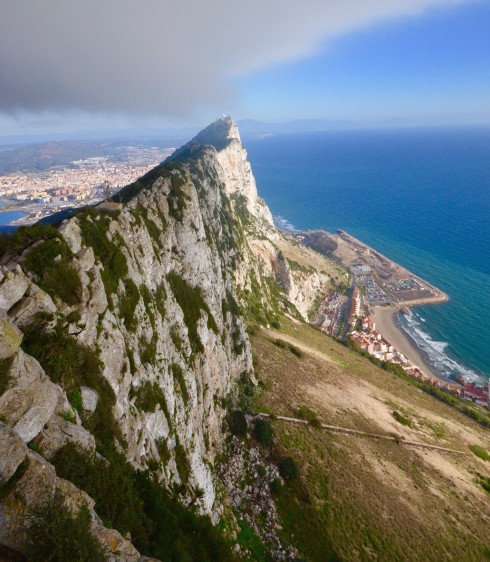
A British sailor was kind enough to take this photo of us on the rock.
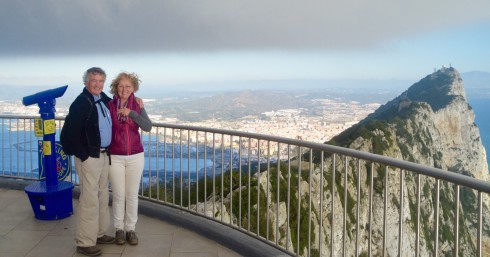
And I reciprocated for him.
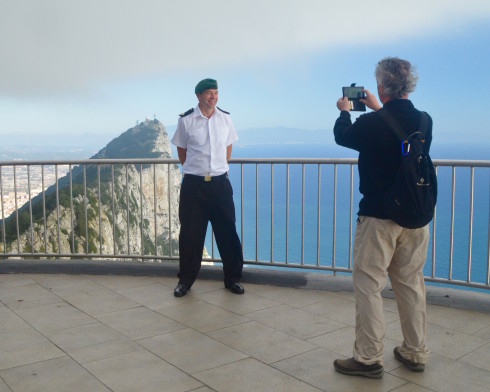
It’s fairly windy up here, as you can see from the colony’s flag.
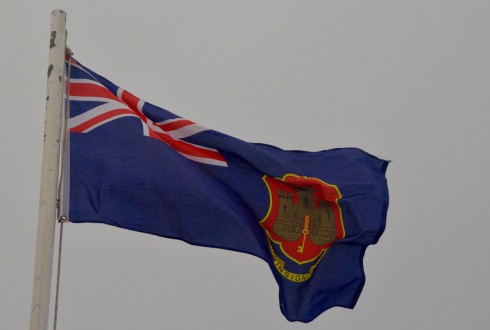
There is a gift shop and restaurant at the top where you can borrow an audioguide that provides more detail on the history of the Rock of Gibraltar, but you must return it before starting on the downward path.
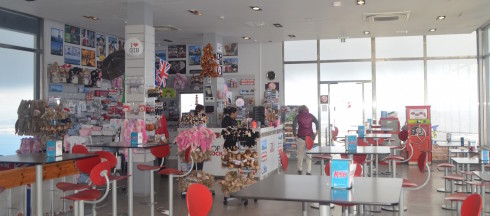
One thing I was not aware of before visiting the Rock of Gibraltar is that the entire top part of the rock is also the Upper Rock Nature Preserve for which you must buy a separate ticket from the cable car fare. The most famous residents of this nature reserve are the celebrated Barbary apes which we are about to meet.
The Barbary Apes of the Rock of Gibraltar
First of all they are not apes, but rather monkeys – macaques to be precise. I last encountered macaques at the Granby zoo in Quebec, but they were in a large compound and not free to roam at will. The ones on the Rock of Gibraltar are the only wild primates in Europe, although they do get fed regularly. We saw our first one at the very top chowing down on carrots. Inside the gift shop area there are photographs of most of the macaques with their names, including two that are apparently very obese and are considered a disgrace to their race.
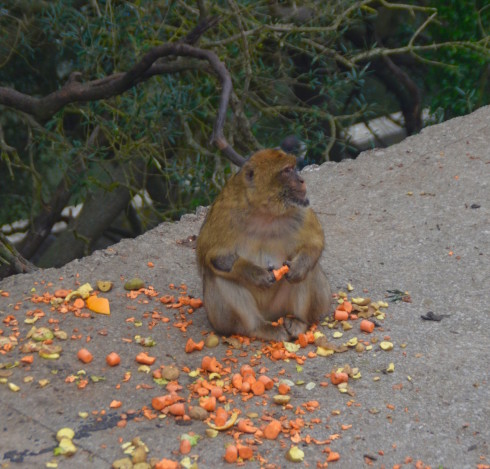
As we headed down the path away from the observatory it didn’t take long to come across a large band of macaques and believe me after interacting with them in their native habitat I know where the saying “As much fun as a barrel of monkeys” comes from. There were macaques of all ages and sizes including the two fatties whose pictures we had seen in the gift shop.
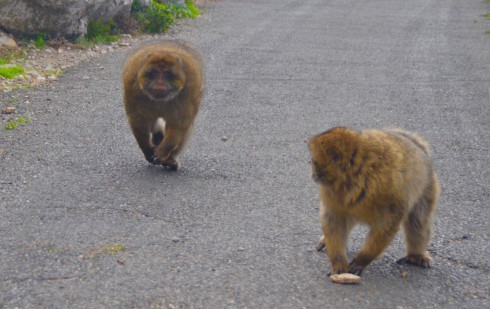
Some of the adults were spending time grooming each other.

While others just sit and look cute.
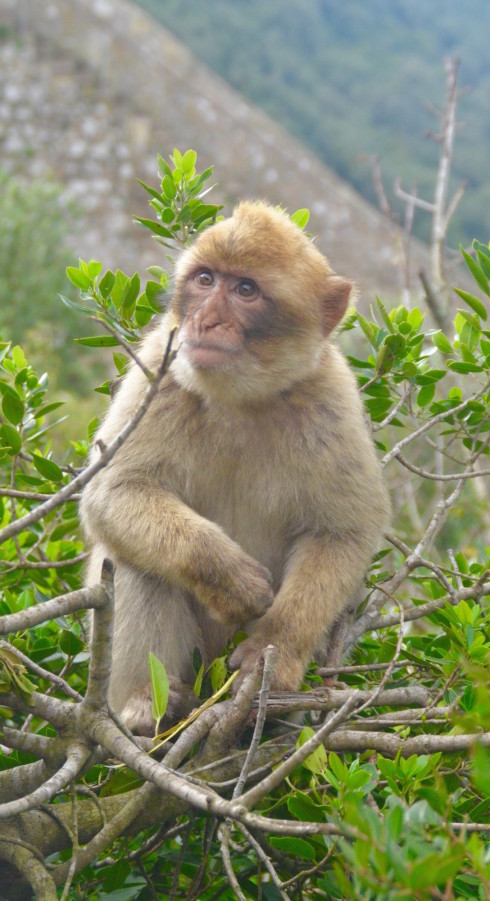
However, by far the most entertaining were two young ones that were playing a game of steal the rag. One would snatch the rag from the other and tear up and down and around before the other one got it back. They did this for a good fifteen minutes before one of the adults put a stop to it by stealing the rag for himself.
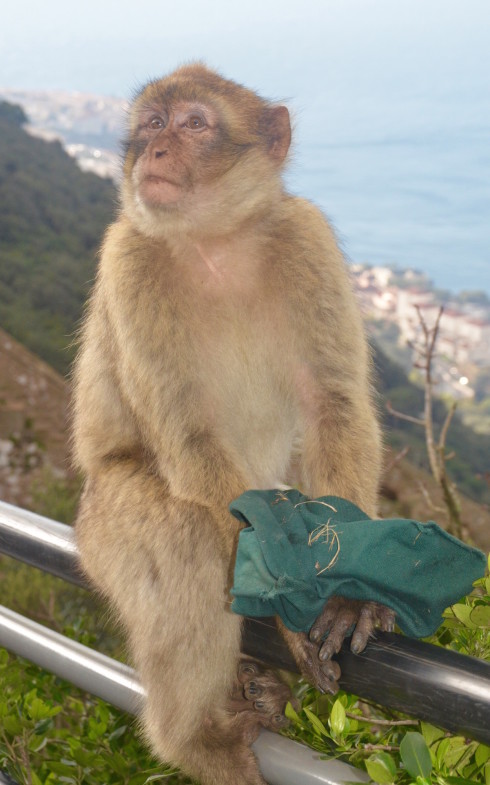
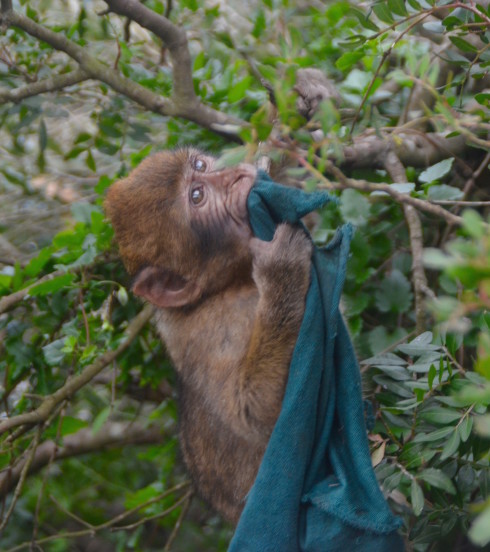
Now there a right and wrong way to get your picture taken with a monkey. Here’s Alison doing it the right way. The little guy is quite demure and camera shy.
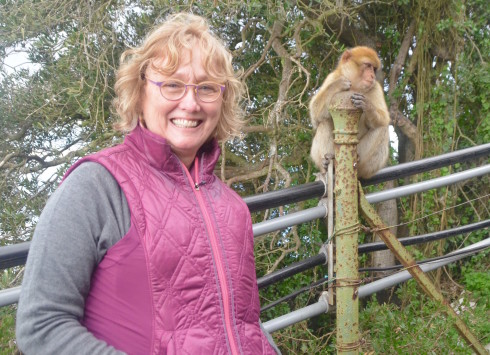
Here’s the wrong way. Alison got the monkey to peer at the camera, but the look of disgust on his face clearly signals that he’s managed to make a monkey out of me.
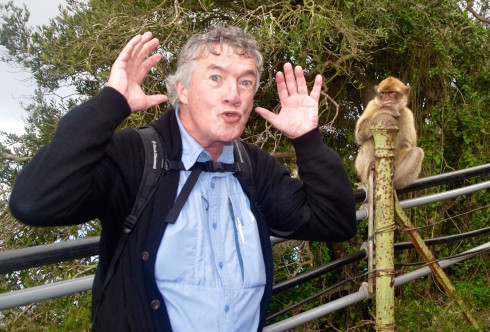
Just seconds after this picture was taken I felt a huge thump on my back and screamed out, “There’s a monkey on my back!” which of course there was. He was trying to open up my backpack and after I flailed at him for a few seconds he jumped back on the rail and just laughed the way only a monkey can do. Now I know why they have these beware of monkeys sign on the roadway. That guy does look kind of sinister, doesn’t he.
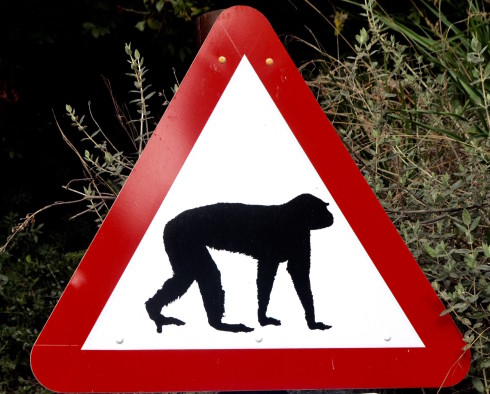
Well I’ve used up every monkey cliché I can think of so we’ll leave the macaques to do their thing and we’ll continue on downward. The guy who jumped on my back looks very penitent so all is forgiven.
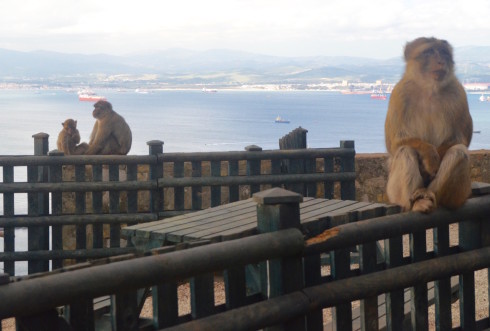
Not long after leaving the monkeys we made a left turn towards O’Hara’s Battery and looking at the map we had I saw what I assumed to be the Mediterranean Steps. According to the map they encircle the southernmost portion of the Rock of Gibraltar. Now, not a lot of thought went into what I proposed to do next – yes, walk down the Mediterranean steps, completing changing the originally planned route. But ‘Wait’, the reader may think. You promised caves and tunnels at the beginning of this post and how are you going to deliver if you walk down those steps? I’ll just have to figure that out later.
So Alison, always believing I know what I am doing sets out down the steps.
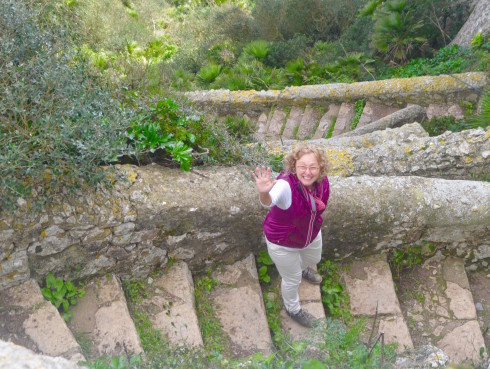
Now don’t get me wrong. The Mediterranean Steps are a definite attraction in themselves. They are 1400 metres or just about a mile and ascend, or in our case, descend, 240 metres, which means they’re pretty steep. In fact, on our descent we meet quite a few people going the other way including one young boy who says “You’re going the wrong way.” As it turns out he was dead on. Here’s the dirty secret about these types of walks. It’s way harder on your knees going down than it is going up. Even though I know this from repeated experiences (Gros Morne, Mount Carleton and the Grand Titon in St. Lucia come to mind), I still can’t resist.
The first thing we notice is that on the Mediterranean side of the Rock of Gibraltar it is way warmer than on the Atlantic side. The second is the profusion of wildflowers including this beautiful Jack-in-the-Pulpit

And this is what I believe to be a variety of pitcher plant.

And wild alyssum which is also very fragrant.
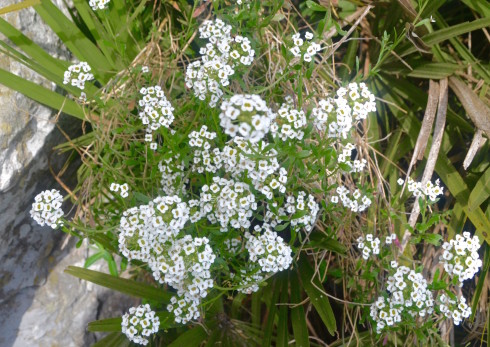
And wild narcissus, something you would never see blooming in the late fall in Canada.

So it is beautiful over on this side, but the steps or in this rare flat portion, path, go on and on and on.
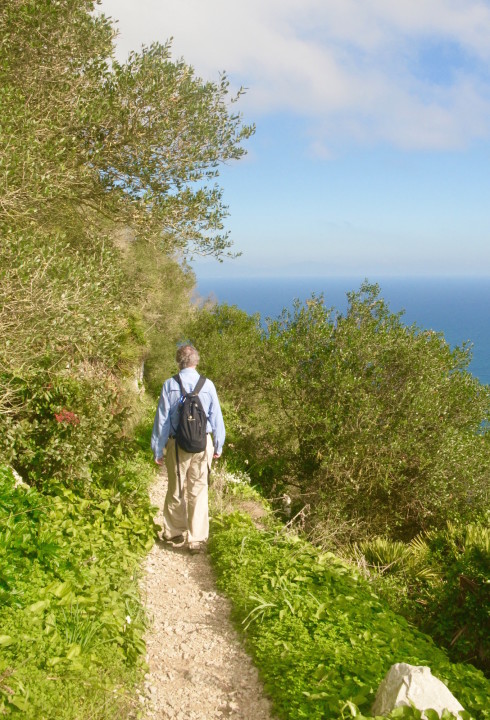
By now my knees are really feeling it and I take a break on top of this old battery with a great view of the Mediterranean which is still incredibly far below.
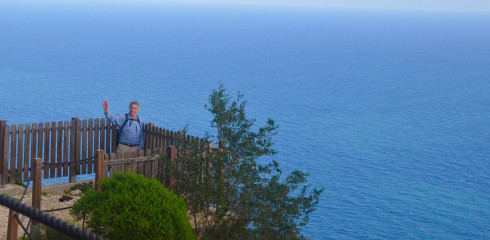
As I look back up it seems highly unlikely that you could come down such a steep cliff, but we did.
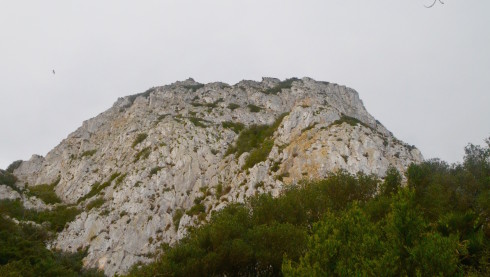
The Mediterranean Steps end with a short walk through a tunnel and although I’m smiling that the walk is finally over, my knees are now screaming in pain
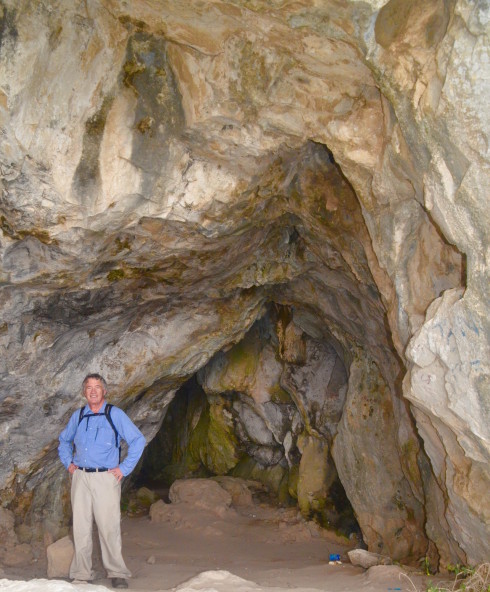
At the end of the steps is the monument marking the Pillars of Hercules. It’s all I can do to haul my sorry carcass up onto it to get a picture.
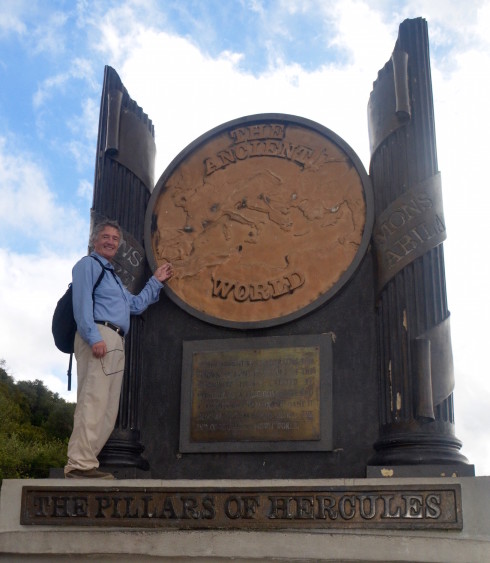
Remember at the beginning of this post that I said I did not want to climb the Rock of Gibraltar? Well guess what, that’s exactly what we’ve got to do next, ailing knees or not.
Join Alison and me in Part 2 of this post as I explain how the rest of the day turned out.

